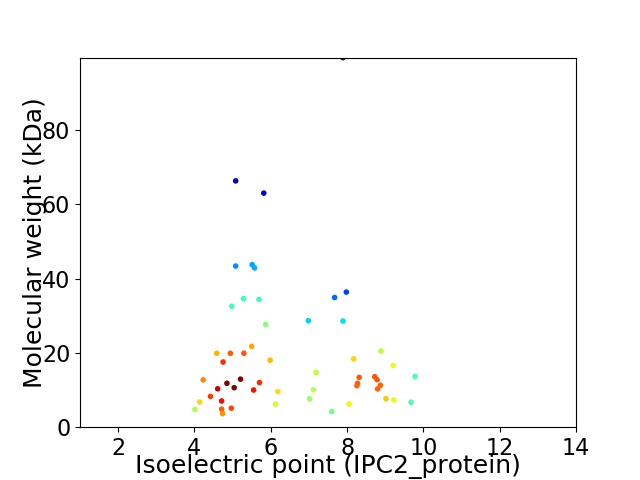
Lactococcus phage P4565
Taxonomy: Viruses; Duplodnaviria; Heunggongvirae; Uroviricota; Caudoviricetes; Caudovirales; Siphoviridae; Skunavirus; Lactococcus virus P4565
Average proteome isoelectric point is 6.46
Get precalculated fractions of proteins

Virtual 2D-PAGE plot for 55 proteins (isoelectric point calculated using IPC2_protein)
Get csv file with sequences according to given criteria:
* You can choose from 21 different methods for calculating isoelectric point
Summary statistics related to proteome-wise predictions



Protein with the lowest isoelectric point:
>tr|A0A649V487|A0A649V487_9CAUD Uncharacterized protein OS=Lactococcus phage P4565 OX=2662297 PE=4 SV=1
MM1 pKa = 7.32KK2 pKa = 10.41VYY4 pKa = 10.54VLSGDD9 pKa = 4.17TYY11 pKa = 9.3CGSWGSEE18 pKa = 3.01ISLFGVFSNKK28 pKa = 9.73EE29 pKa = 4.0EE30 pKa = 4.09ADD32 pKa = 3.56KK33 pKa = 11.28LADD36 pKa = 4.3EE37 pKa = 4.52MQCDD41 pKa = 3.37ISVVNIDD48 pKa = 3.63EE49 pKa = 4.27VEE51 pKa = 4.03EE52 pKa = 4.09PKK54 pKa = 10.79RR55 pKa = 11.84LGGYY59 pKa = 9.95CEE61 pKa = 3.92
MM1 pKa = 7.32KK2 pKa = 10.41VYY4 pKa = 10.54VLSGDD9 pKa = 4.17TYY11 pKa = 9.3CGSWGSEE18 pKa = 3.01ISLFGVFSNKK28 pKa = 9.73EE29 pKa = 4.0EE30 pKa = 4.09ADD32 pKa = 3.56KK33 pKa = 11.28LADD36 pKa = 4.3EE37 pKa = 4.52MQCDD41 pKa = 3.37ISVVNIDD48 pKa = 3.63EE49 pKa = 4.27VEE51 pKa = 4.03EE52 pKa = 4.09PKK54 pKa = 10.79RR55 pKa = 11.84LGGYY59 pKa = 9.95CEE61 pKa = 3.92
Molecular weight: 6.79 kDa
Isoelectric point according different methods:
Protein with the highest isoelectric point:
>tr|A0A649V335|A0A649V335_9CAUD Uncharacterized protein OS=Lactococcus phage P4565 OX=2662297 PE=4 SV=1
MM1 pKa = 7.71AMNSLNTSIIAKK13 pKa = 9.7EE14 pKa = 3.96MQTKK18 pKa = 7.47VTEE21 pKa = 4.24RR22 pKa = 11.84MGDD25 pKa = 2.9WFEE28 pKa = 5.71AEE30 pKa = 4.89FKK32 pKa = 11.05AKK34 pKa = 10.55ANAAARR40 pKa = 11.84RR41 pKa = 11.84TRR43 pKa = 11.84LIRR46 pKa = 11.84SHH48 pKa = 5.25GHH50 pKa = 5.21TYY52 pKa = 9.84TYY54 pKa = 11.14ARR56 pKa = 11.84HH57 pKa = 5.57QNTGQLARR65 pKa = 11.84NLKK68 pKa = 8.49QVKK71 pKa = 10.03KK72 pKa = 9.94GDD74 pKa = 3.72KK75 pKa = 9.93VVVNAGTRR83 pKa = 11.84ANYY86 pKa = 9.92SSGYY90 pKa = 8.88HH91 pKa = 5.38GMYY94 pKa = 10.52FLVEE98 pKa = 4.16KK99 pKa = 10.74KK100 pKa = 10.71GMQDD104 pKa = 3.28VKK106 pKa = 9.28TTLKK110 pKa = 10.68KK111 pKa = 10.0GANYY115 pKa = 9.69ANSMKK120 pKa = 10.65LL121 pKa = 3.26
MM1 pKa = 7.71AMNSLNTSIIAKK13 pKa = 9.7EE14 pKa = 3.96MQTKK18 pKa = 7.47VTEE21 pKa = 4.24RR22 pKa = 11.84MGDD25 pKa = 2.9WFEE28 pKa = 5.71AEE30 pKa = 4.89FKK32 pKa = 11.05AKK34 pKa = 10.55ANAAARR40 pKa = 11.84RR41 pKa = 11.84TRR43 pKa = 11.84LIRR46 pKa = 11.84SHH48 pKa = 5.25GHH50 pKa = 5.21TYY52 pKa = 9.84TYY54 pKa = 11.14ARR56 pKa = 11.84HH57 pKa = 5.57QNTGQLARR65 pKa = 11.84NLKK68 pKa = 8.49QVKK71 pKa = 10.03KK72 pKa = 9.94GDD74 pKa = 3.72KK75 pKa = 9.93VVVNAGTRR83 pKa = 11.84ANYY86 pKa = 9.92SSGYY90 pKa = 8.88HH91 pKa = 5.38GMYY94 pKa = 10.52FLVEE98 pKa = 4.16KK99 pKa = 10.74KK100 pKa = 10.71GMQDD104 pKa = 3.28VKK106 pKa = 9.28TTLKK110 pKa = 10.68KK111 pKa = 10.0GANYY115 pKa = 9.69ANSMKK120 pKa = 10.65LL121 pKa = 3.26
Molecular weight: 13.66 kDa
Isoelectric point according different methods:
Peptides (in silico digests for buttom-up proteomics)
Below you can find in silico digests of the whole proteome with Trypsin, Chymotrypsin, Trypsin+LysC, LysN, ArgC proteases suitable for different mass spec machines.| Try ESI |
 |
|---|
| ChTry ESI |
 |
|---|
| ArgC ESI |
 |
|---|
| LysN ESI |
 |
|---|
| TryLysC ESI |
 |
|---|
| Try MALDI |
 |
|---|
| ChTry MALDI |
 |
|---|
| ArgC MALDI |
 |
|---|
| LysN MALDI |
 |
|---|
| TryLysC MALDI |
 |
|---|
| Try LTQ |
 |
|---|
| ChTry LTQ |
 |
|---|
| ArgC LTQ |
 |
|---|
| LysN LTQ |
 |
|---|
| TryLysC LTQ |
 |
|---|
| Try MSlow |
 |
|---|
| ChTry MSlow |
 |
|---|
| ArgC MSlow |
 |
|---|
| LysN MSlow |
 |
|---|
| TryLysC MSlow |
 |
|---|
| Try MShigh |
 |
|---|
| ChTry MShigh |
 |
|---|
| ArgC MShigh |
 |
|---|
| LysN MShigh |
 |
|---|
| TryLysC MShigh |
 |
|---|
General Statistics
Number of major isoforms |
Number of additional isoforms |
Number of all proteins |
Number of amino acids |
Min. Seq. Length |
Max. Seq. Length |
Avg. Seq. Length |
Avg. Mol. Weight |
|---|---|---|---|---|---|---|---|
0 |
9573 |
33 |
934 |
174.1 |
19.79 |
Amino acid frequency
Ala |
Cys |
Asp |
Glu |
Phe |
Gly |
His |
Ile |
Lys |
Leu |
|---|---|---|---|---|---|---|---|---|---|
5.714 ± 0.484 | 0.606 ± 0.109 |
5.818 ± 0.211 | 7.333 ± 0.565 |
4.293 ± 0.241 | 6.247 ± 0.465 |
1.16 ± 0.155 | 7.26 ± 0.398 |
9.172 ± 0.448 | 8.754 ± 0.379 |
Met |
Asn |
Gln |
Pro |
Arg |
Ser |
Thr |
Val |
Trp |
Tyr |
|---|---|---|---|---|---|---|---|---|---|
2.434 ± 0.196 | 6.968 ± 0.423 |
2.235 ± 0.216 | 3.698 ± 0.266 |
3.353 ± 0.256 | 6.383 ± 0.437 |
6.55 ± 0.337 | 6.268 ± 0.318 |
1.4 ± 0.127 | 4.356 ± 0.369 |
Most of the basic statistics you can see at this page can be downloaded from this CSV file
Proteome-pI is available under Creative Commons Attribution-NoDerivs license, for more details see here
| Reference: Kozlowski LP. Proteome-pI 2.0: Proteome Isoelectric Point Database Update. Nucleic Acids Res. 2021, doi: 10.1093/nar/gkab944 | Contact: Lukasz P. Kozlowski |
